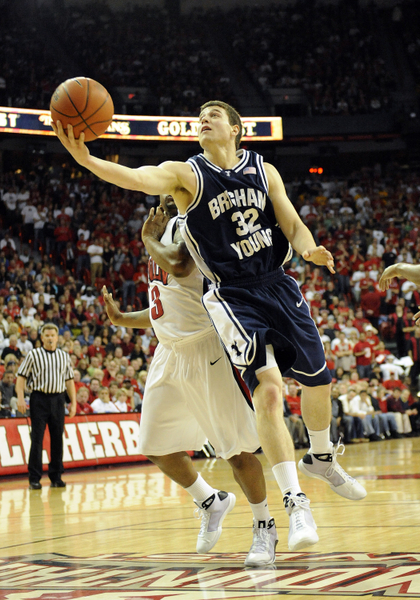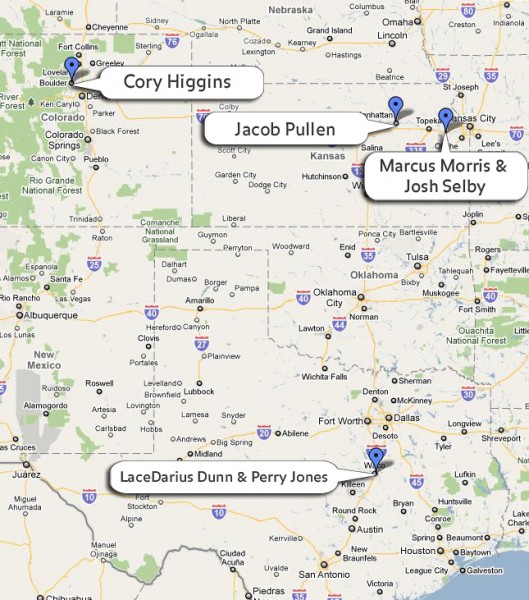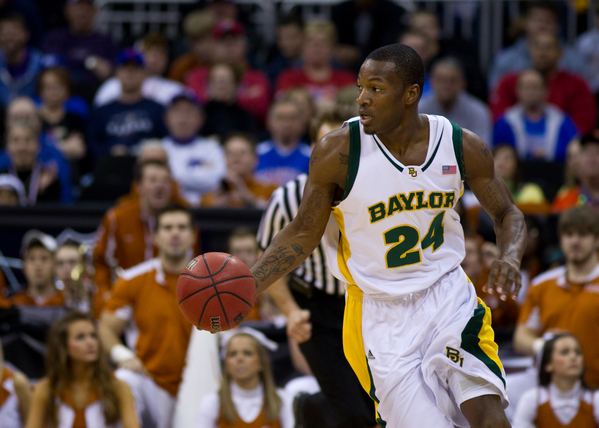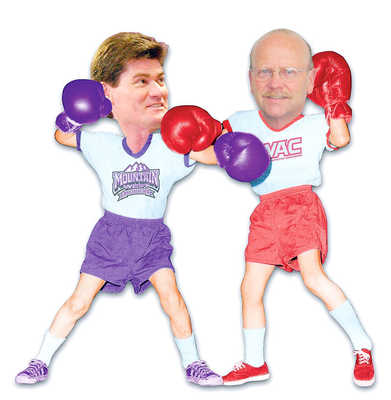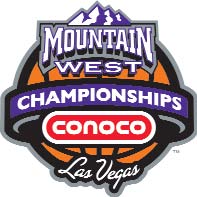Checking in on… the Mountain West
Posted by Brian Goodman on December 7th, 2010Andrew Murawa is the RTC correspondent for the Mountain West and Pac-10 conferences
A Look Back
This week was about as good of a week as the Mountain West can expect to have. Not only did member institutions glide through the MWC/MVC Challenge on their way to an 8-1 victory, but of the 18 games played involving MWC teams this week, the MWC posted a 16-2 record, with only a hard-fought TCU loss to Northern Iowa and an entirely predictable embarrassing Wyoming loss to South Dakota on the negative side of the ledger. As a whole, the conference boasts three remaining undefeated teams (San Diego State, UNLV and BYU – all three ranked in our RTC top 25), three other teams with a lone loss and a composite 53-13 record.
Last year at this time, New Mexico, UNLV and BYU had earned a combined 21-1 record and had separated themselves from the rest of the conference as the teams to beat, and this season, a similar separation has occurred. But last year, after a relatively slow start to the season, San Diego State came on strong down the stretch, winning nine of their last ten games (including the MWC Championship) before bowing out in the first round of the NCAA Tournament. This year’s version of the Aztecs, a team that is capable of improving drastically over the back end of the season could be last year’s regular season champion, New Mexico, a team who is just now starting to get some of their newcomers comfortable and who still awaits the midseason addition of transfer Drew Gordon. The rest of the conference is still sorting itself out, but while there are hiccups here and there, the conference as a whole appears stronger than last year’s very strong performance.
Team of the Week: Air Force – A couple weeks back, as the Falcons were losing to Division III’s Colorado College, I would have put the odds of Air Force ever occupying this space in 2010-11 as absurdly slim. But, these days, the Falcons are on a four-game winning streak, and while they haven’t exactly beaten up on the Dukes and Georgetowns of the world, wins over Wofford (the Falcons first road victory in almost two years), CS Northridge and Evansville (a team that already beat Butler this season) are good wins for a team that finished 9-20 a year ago. This week, the Academy got solid contributions from up and down their roster, but special attention should be paid to sophomore center Taylor Broekhuis who averaged 15.5 points per game this week and knocked down five threes as the Falcons edged Evansville on a free throw by fellow sophomore Mike Lyons in the waning moments of their game on Sunday. While not the most athletic team and prone to getting killed on the boards on both ends of the floor, Air Force has outdueled their opposition by taking care of the ball and playing great defense, limiting opposing teams to just 34.8% shooting from the field. While still not a huge threat against the upper echelon teams in the conference, head coach Jeff Reynolds has at least shown that after hitting rock bottom, this team is at least moving in the right direction again.
Player of the Week: Andy Ogide, Colorado State – Ogide posted his eighth and ninth double-doubles of his career this week in leading his Rams to a pair of wins over Drake and Fresno State, while averaging 17 points and 10.5 rebounds. CSU was in need of some serious toughness and veteran leadership after a disturbing loss to Sam Houston State on 11/27, in which they were outrebounded and outhustled throughout, and the senior responded, hitting 15 of his 22 shots and controlling the paint for the Rams, opening up the perimeter for CSU’s talented shooters to knock down 18 of their 37 three-point attempts on the week. For the Rams to compete for the post-season berth that they dream of, they’ll need Ogide to match these types of efforts the rest of the way.
Newcomer of the Week: Josh Watkins, Utah – On the heels of Utah’s Will Clyburn winning this award the first two weeks out, it is time for a little variety, in the form of another Utah junior college transfer. Watkins and Clyburn have been the dynamic duo early for the Utes this year as they have run out to a 5-2 record. Watkins, a 6’0 junior point guard, is second on the team in scoring, averaging 17 points a night, and this week, he became the first Ute besides Clyburn to lead the team in scoring for a game when he tossed in a career-high 23 points (including three three-pointers) as the Utes went to Peoria and knocked off Bradley. Watkins is the only UU player with double-digit assists on the season (he is averaged 3.5 assists a game), but he has two more turnovers on the season than assists. While Watkins has given the Utes a good scoring punch in the backcourt, he’ll need to tighten up his handle and work on dropping more dimes for his teammates than for his opponents, but for now, his contribution to his team is definitely more positive than negative.
Game of the Week: Air Force 57, Evansville 56 – The Falcons posted their fourth win in a row and wrapped up a dominating performance by the Mountain West in the MWC/MVC Challenge with this AFA win over Evansville on Sunday, but it didn’t come easy as the teams combined for just 19 points in the final ten minutes of the game. Falcon sophomore center Taylor Broekhuis put Air Force up 56-53 with his fifth three of the game, just under two minutes, but was answered immediately following an Aces timeout by sophomore Colt Ryan fifth three of the game as well, tying things back up. Following an Air Force turnover, the Falcons inability to secure a defensive rebound forced them to play defense for almost 70 seconds, but Evansville junior Denver Holmes missed an open jumper that was secured by Falcon senior Derek Brooks, who immediately turned upcourt and fired an outlet pass to sophomore Mike Lyons who raced upcourt and attacked the basket, drawing a foul at the rim. He made just the first of two free throws but that accounted for the Falcon win.
Game of the Upcoming Week: UNLV at Louisville, 12/11, 9 AM PST, ESPNU. – There are quite a few very interesting games this week around the Mountain West, with each of the three remaining undefeated teams having one big battle on their hands at some point, but we’ll give this one the nod as perhaps the biggest challenge of the week. Not only do the Running Rebels have to travel to Louisville and their new arena, but the Cardinals will have some revenge on their mind after UNLV squeaked one out over Rick Pitino’s gang last season at the Thomas and Mack Center. To make matters worse, the Rebels will have to fly east and play this game bright and early on Saturday morning. And, given the old adage that pressing teams hate to be pressed, we’ll see which of these teams, both of whom rely on defensive pressure as a key component in their success, will wither under defensive duress.
Power Rankings
1. San Diego State (8-0): After spending the first two weeks of the season on the road, the Aztecs have now had a chance to spend the last two weeks at Viejas Arena, and a little home-cooking looks awful good on them. With two big tests rolling through town this week, in the form of St. Mary’s and Wichita State, and with both tests passed with flying colors, Aztec fans are starting to believe that this is a special team, loaded with tons of talent and veteran leadership. If one wasn’t aware of this already, they need look no further than a spectacular 14-0 run in the span of 67 seconds in SDSU’s win over Wichita State on Saturday, where the Aztecs forced turnovers, got out on the break and converted two three-point plays, one four-point play (following a WSU intentional foul) and a couple other field goals, in blowing the game open as part of a larger 21-3 run that turned a one-point deficit into a 17-point lead in the blink of an eye. Malcom Thomas had a big week for the Aztecs (12 PPG, 5.5 RPG and 5 BPG), but head coach Steve Fisher is getting contributions from up and down his roster, with six players presently averaging over eight points per game.
A Look Ahead: One of the last big tests in the non-conference for the Aztecs comes up on Wednesday night when they travel to Berkeley to face Cal. While Cal has famously struggled scoring the ball early this season, they did already hang a 25-point loss on SDSU’s MWC rival, New Mexico, so the Aztecs should come into that game ready. On Saturday, they’ll return home to face cross-town rival San Diego, a program that is currently a shell of its former self. In all likelihood, if the Aztecs can get through Cal, they’re looking at a 15-0 record heading into conference play in January, with only a 12/18 matchup with UC Santa Barbara even remotely scary the rest of the way in the non-conference docket.
2. UNLV (8-0): The Rebels backed up their 76 Classic victory with a couple good road wins this week, a 31-point crushing of Illinois State in the MWC/MVC Challenge, and then a 12-point win over in-state rival Nevada in Reno in Saturday night, and now boast an 8-0 record for the first time since the famed 1990-91 Running Rebel team. Junior point Oscar Bellfield led the Rebs this week with 17.5 points per night and eight total threes, but six players scored in double figures at some point this week, and this Rebels fairly coasted through a tough set of road games. In the Nevada game, UNLV didn’t allow a field goal for most of the first 11 minutes of the game and led 22-2 before the Wolfpack eventually got on the board on the way to a 46-25 halftime lead before Lon Kruger’s bunch lost some focus in the second half.
A Look Ahead: Boise State visits Vegas on Wednesday before the Rebs head to Louisville on Saturday for a tough early-morning matchup with the Cardinals.
3. BYU (8-0): Here’s how strong the top of the MWC is: the Cougars didn’t play a home game this week (technically, at least – they did play in Salt Lake City against Hawai’i which is close enough for government work), still posted a couple more wins by an average of 16.5 points, and still drop a step in my rankings. To defend that decision, I would just say that the two teams above BYU seem to have their rotation and roles more firmly set than the Cougars do, although head coach Dave Rose seems to get more and more answers each week as the season rolls on. This week alone, four different Cougars posted career-highs in points, with sophomore forward Brandon Davies going for 24 points (with a side of six rebounds to boot) and freshman guard Kyle Collinsworth adding 12 points (and ten rebounds – that a career high as well) in a 12-point win over Creighton in Omaha, before freshman Stephen Rogers went for 12 and senior forward Logan Magnusson added ten against Hawai’i. Sophomore Chris Collinsworth missed both games this week due to an ankle injury, and he remains day-to-day.
A Look Ahead: An eventful week for BYU, as they head to Glens Falls, New York to face Vermont in a homecoming game for senior guard Jimmer Fredette, before heading back to Salt Lake City for a big-league matchup with Arizona. After the hullabaloo of the trip to Glens Falls and its attendant demands on Fredette, the follow-up game with the Wildcats is even more of a test as the young and inconsistent Cougar front line will have to deal with Arizona’s All-American type forward, Derrick Williams.
4. New Mexico (6-1): A couple games, a couple wins, as the Lobos start to fold in their newcomers with the battle-tested veterans of last season’s conference champions. This week, sophomore forward Emmanuel Negedu made his first major contributions for his new school with his 11-point, eight-rebound performance in a mere night minutes during UNM’s win over Southern Illinois. In doing so, he earned more minutes in the Lobos next game, 23 to be exact at New Mexico State, and while the scoring and rebounding numbers were down some, he did reject three Aggie shots. Elsewhere, Phillip McDonald is working his way back from an early-season elbow injury, and has added a presence on the glass that was absent in his first two years in Albuquerque, pulling down 19 rebounds this week, while also going for 14.5 points per night and adding five threes this week. Then there’s freshman guard Kendall Williams, who has averaged over ten points a game for Steve Alford and dropped a career-high 17 points, including three more threes (he’s now 11-19 from deep on the season) in the New Mexico State game. With senior point guard Dairese Gary still plugging along as his usual excellent self, this Lobo team has the potential to grow into a very tough out by March.
A Look Ahead: The second half of the battle of the Land of Enchantment, as the Aggies repay New Mexico with a visit into the Pit. Beyond that, it’s study hall for the Lobos.
5. Colorado State (4-1): As we mentioned above, the Rams were in major need of a bounce-back performance following a disappointing loss to Sam Houston State, and bounce back they did with two good wins over Drake and Fresno State. While we named Andy Ogide as our MWC player of the week, he got plenty of help from his teammates this week. In particular, senior Andre McFarland averaged 14.5 points per game and knocked down seven of the Rams’ 18 three-pointers on the week, while sophomore transfer Wes Eikmeier added 11 assists. But, by and large, this CSU squad has been a deep team getting production from all over, with ten players averaging at least ten minutes a game and eight players having scored in double digits this season. There isn’t a ton of big talent on this squad, so Tim Miles will need to keep his team alert to the need to rebound and defend the interior as a team, but if the Rams keep hitting from the field at a rate anywhere near what they’ve been doing so far (their 60% effective field goal percentage is good for fourth in the nation), they’ll have a bombers chance against anybody.
A Look Ahead: The Rams get a taste of life in the Big 12 this week, as they travel to Boulder for a winnable game against Colorado before they get brought back down to earth in Kansas City with a neutral-site matchup with Kansas.
6. Utah (5-2):The Utes got through a pretty tough week unscathed, knocking off Fresno State at home and following that up with an impressive road victory at Bradley. Junior college transfers Will Clyburn (20 PPG this week) and Josh Watkins (19.5 PPG this week) continue to lead the way for head coach Jim Boylen, but the Utes also got a big boost from another JuCo transfer, Chris Kupets, who had a career-high 17 points in the Fresno win. Good news on the injury front for the Utes as well as junior center David Foster started against Bradley and got his first start of the season while playing 20 minutes, and senior Jay Watkins’ back continues to improve.
A Look Ahead: Utah’s schedule continues to be a good match for their skill level: lots of games against middle-of-the-road competition, very few cupcakes, very few killers. This continues this week with a home game against Pepperdine and a road trip to Ann Arbor to face the Wolverines. Both of these games are good tests for the Utes, with the Michigan game, in particular, a game that they’ll need to play their best to win.
7. TCU (6-3): While the Horned Frogs were the only MWC team to lose their MWC/MVC Challenge game, their loss is nothing to be particularly ashamed about. They dropped a close game to Northern Iowa, a Sweet 16 team from a year ago, after fighting the Panthers the whole way. This edition of the Frogs is a flawed team, with a tiny backcourt and a lot of youth and inexperience, but head coach Jim Christian is really doing a much better job with this team than with last year’s more talented bunch. While his team doesn’t place a lot of importance on hitting the offensive boards, they are doing a great job of cleaning the glass on the defensive end, and they are a more athletic team up and down the roster than they were last year, with 6’8 freshman Amric Fields, 6’5 junior J.R. Cadot and 6’4 junior Sammy Yeager giving the team a handful of bouncy, if undersized, frontcourt players
A Look Ahead: It’s a Big 12 road trip around the MWC, with TCU joining CSU in a little MWC/Big 12 mini-challenge. The Horned Frogs have a little bit more manageable pair of games, however, with trips to Texas Tech and Nebraska on the slate – games that, while tough, are winnable.
8. Air Force (5-1): We’ve said just about everything that needs to be said about the Falcons in our Team of the Week and Game of the Week sections above, and there are lots of good things to be said about this team right now, but let’s just remember that while this is a team that is going to play hard night in and night out throughout the season and defend like crazy, there isn’t a lot of firepower on this team. When they’re in a game with a team that isn’t going to blow them away with athleticism (see Evansville), they are capable of sticking around just through shooting and defending like crazy, and when they are in a game with a wilder team that is looser with the ball (see CS Northridge), they can take advantage and outsmart their opponents. But, as they get into conference play and start seeing a higher level of athleticism and of basketball smarts, we will likely be reminded that this is a relatively unathletic bunch without much in the way of consistent playmakers. For now though, just enjoy the ride.
A Look Ahead: A very tough roadie on Wednesday with a trip to Dayton to face Wright State. This is the type of team that should give the Falcons a lot of trouble, and as such, this will be a good litmus test to see how far Air Force has come. Luckily enough, the Falcons follow that up with a visit by North Carolina Central to Colorado Springs.
9. Wyoming (3-5): The good news: the Cowboys held up their end of the deal by knocking off Indiana State in the MWC/MVC Challenge behind five players scoring in double figures. Wyoming held the Sycamores to 29.4% shooting from the field and forced 22 turnovers while only committing eight themselves. Of course, the bad news is that three days prior, the Cowboys made a weird road trip to Vermillion, South Dakota for a matchup with the Coyotes in front of 1,768 fans in the DakotaDome and got completely outshot in the second half, hitting just 37.5% from the field while their opponent knocked down 52.2%. Desmar Jackson led the Cowboys with 15.5 points a night for a team that is just a mess right now, failing to live up to their talent on a regular basis.
A Look Ahead: A Friday trip to UC Irvine for the Cowboys, a game that should be completely winnable, but given the state of this program, is probably a coin flip at best.
































